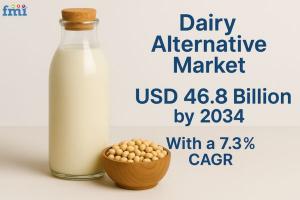Dairy Alternative Market Set to Double by 2034, Reaching USD 46.8 Billion Amid Rising Demand for Plant-Based Nutrition
Growing consumer preference for sustainable and vegan products is driving the demand for dairy alternatives globally.
Growing health consciousness, dietary restrictions, veganism, and environmental sustainability concerns are reshaping consumer choices. Dairy alternatives such as plant-based milk, yogurt, cheese, butter, and ice cream have surged in popularity across global markets, catering to both lactose-intolerant individuals and health-focused consumers seeking nutritional variety.
Uncover Market Opportunities: Access a Sample Report Now: https://www.futuremarketinsights.com/reports/sample/rep-gb-4852
Market Trends Highlighted:
Rising popularity of oat, almond, soy, and coconut-based dairy substitutes.
Growth in functional dairy alternatives with added protein, vitamins, and probiotics.
Expansion of plant-based offerings in mainstream foodservice chains and supermarkets.
Increasing focus on clean-label, organic, and fortified plant-based dairy products.
Product innovations catering to regional flavor preferences and ethnic cuisines.
Developments:
• Major FMCG players are introducing diverse dairy-free lines, including cheese slices, spreads, and yogurts, to meet growing consumer demand.
• Investment in new processing technologies to improve texture, taste, and nutritional profiles of plant-based dairy products.
• Private-label products gaining market share, especially in North America and Europe.
• Collaborations with celebrity chefs and influencers to drive adoption and appeal to younger demographics.
• Expansion of e-commerce channels for direct-to-consumer sales of dairy-free alternatives.
Accelerated Market Demand: Find Comprehensive Insights and Trends in Our Full Report: https://www.futuremarketinsights.com/reports/dairy-alternatives-market
Key Takeaways of the Report:
• Global market to nearly double, from USD 23 billion in 2024 to USD 46.8 billion by 2034.
• Growth supported by increasing vegan and flexitarian populations worldwide.
• Germany leads in CAGR (8.8%), followed by India (6.8%).
• Demand for fortified, protein-rich plant-based milk alternatives on the rise.
• Growing awareness regarding environmental impact of dairy farming fueling demand for alternatives.
Market Drivers:
1. Growing Health and Wellness Trends:
The rising awareness of cholesterol-free, lactose-free, and allergen-friendly foods is pushing consumers toward dairy alternatives.
2. Veganism and Flexitarianism:
Consumers globally are adopting vegan and flexitarian diets driven by animal welfare concerns, sustainability, and perceived health benefits.
3. Lactose Intolerance Prevalence:
With a significant portion of the global population suffering from lactose intolerance, dairy-free products offer essential alternatives to traditional dairy.
4. Environmental Sustainability Concerns:
The high carbon footprint and water consumption associated with conventional dairy production is driving eco-conscious consumers toward plant-based substitutes.
5. Expansion of Distribution Channels:
Dairy alternatives are now widely available in supermarkets, health food stores, cafes, and online, increasing consumer accessibility.
Regional Insights:
United States (4.3% CAGR):
The U.S. dairy alternative market remains one of the largest globally, with robust product offerings in supermarkets and cafes. Growth is driven by rising lactose intolerance diagnoses, health-conscious millennials, and mainstream acceptance of vegan diets. Additionally, private-label brands are capturing significant market share as affordability becomes a deciding factor in consumer choice.
China (3.5% CAGR):
Though growing at a slower rate, China’s dairy alternative market is supported by increasing lactose intolerance awareness and demand for imported, premium-quality plant-based dairy substitutes. Innovations in soy and oat milk products, coupled with rising urbanization and modern retail expansion, are strengthening China’s position in the regional market.
Germany (8.8% CAGR):
Germany leads globally with the highest CAGR of 8.8%, propelled by environmental awareness, animal welfare concerns, and proactive government policies supporting plant-based diets. German consumers are increasingly seeking organic, fortified, and sustainable dairy-free options, driving innovation and sales.
India (6.8% CAGR):
India’s growth is fueled by lactose intolerance prevalence across significant segments of the population, along with a cultural inclination towards plant-based foods. Rapid urbanization, rising disposable incomes, and increasing health consciousness further support market expansion, especially in metropolitan areas.
United Kingdom (4.9% CAGR):
The U.K. continues to witness steady growth, supported by a burgeoning vegan population, increased product availability in retail chains and cafes, and celebrity endorsements promoting plant-based lifestyles. Government sustainability initiatives and consumer preference for fortified, functional foods are additional growth catalysts.
Country-wise CAGR Analysis (2024–2034):
Country CAGR (%)
United States 4.3%
China 3.5%
Germany 8.8%
India 6.8%
United Kingdom 4.9%
Competition Outlook:
The global dairy alternative market is highly competitive and rapidly evolving, with both multinational corporations and regional players vying for market share. The competition is centered around product quality, innovation, taste profile, and nutritional benefits.
Key Market Players
• The Hain Celestial Group, Inc.
• SunOpta Inc.
• Danone
• Oatly
• Vitasoy International Holdings Limited
• DAIYA FOODS INC.
• Melt Organic
• Living Harvest Foods Inc.
• Ripple Foods
• Earth’s Own Food Company Inc.
• ADM
• The Whitewave Foods Company
• Eden Foods, Inc.
• Nutriops, S.L.
• Freedom Foods Group Ltd.
• Blue Diamond Growers
• CP Kelco
• Organic Valley Family of Farms
• Others
Explore Dairy Alternatives Industry Analysis: https://www.futuremarketinsights.com/industry-analysis/dairy-alternatives
Key Segments Covered in the Dairy Alternative Market
By Source:
• Soy
• Almond
• Rice
• Coconut
• Oats
• Others
By Product:
• Regular/ Unflavoured
o Soy Milk
o Almond Milk
o Coconut Milk
o Oat Milk
o Others (Hemp, Flax, etc.)
• Flavored
o Soy Milk
o Almond Milk
o Coconut Milk
o Oat Milk
o Others (Hemp, Flax, etc.)
By Nature:
• Organic
• Conventional
By Distribution Channel:
• Direct Sales/ B2B
• Indirect Sales/ B2C
o Hypermarkets/ Supermarkets
o Convenience Stores
o Mass Grocery Retailers
o Specialty Stores
o Online Retail
By Region:
• North America
• Latin America
• Europe
• Asia Pacific
• Middle East & Africa (MEA)
• Others
Explore FMI’s related ongoing Coverage in Food and Beverage Domain:
Dairy-free Evaporated Milk Market:https://www.futuremarketinsights.com/reports/dairy-free-evaporated-milk-market
Dairy Protein Crisps Market:https://www.futuremarketinsights.com/reports/dairy-protein-crisps-market
Dairy Products Market: https://www.futuremarketinsights.com/reports/dairy-products-market
About Future Market Insights (FMI)
Future Market Insights, Inc. (ESOMAR certified, recipient of the Stevie Award, and a member of the Greater New York Chamber of Commerce) offers profound insights into the driving factors that are boosting demand in the market. FMI stands as the leading global provider of market intelligence, advisory services, consulting, and events for the Packaging, Food and Beverage, Consumer Technology, Healthcare, Industrial, and Chemicals markets. With a vast team of over 400 analysts worldwide, FMI provides global, regional, and local expertise on diverse domains and industry trends across more than 110 countries.
Contact Us:
Future Market Insights Inc.
Christiana Corporate, 200 Continental Drive,
Suite 401, Newark, Delaware – 19713, USA
T: +1-347-918-3531
Website: https://www.futuremarketinsights.com
Ankush Nikam
Future Market Insights, Inc.
+ +91 90966 84197
email us here
Visit us on social media:
LinkedIn
Facebook
YouTube
X
Legal Disclaimer:
EIN Presswire provides this news content "as is" without warranty of any kind. We do not accept any responsibility or liability for the accuracy, content, images, videos, licenses, completeness, legality, or reliability of the information contained in this article. If you have any complaints or copyright issues related to this article, kindly contact the author above.
Chronicle Associates Showcases Client Success with Three-Book Collaboration with Tim Scott
بحضور 10,000 متفرج.. عمرو دياب يُشعل مسرح عبادي الجوهر أرينا في جدة بأمسية لا تُنسى
Advancing Health Workforce Development Through Open Science and UN SDG 3 Goals; Olumuyiwa Bamgbade, Salem Pain Clinic
Więcej ważnych informacji
 Jedynka Newserii
Jedynka Newserii

 Jedynka Newserii
Jedynka Newserii

Handel

Polskie MŚP otrzymają większe wsparcie w ekspansji międzynarodowej. To cel nowej inicjatywy sześciu instytucji
Firmy z sektora małych i średnich przedsiębiorstw otrzymają kompleksowe wsparcie na potrzeby zwiększania konkurencyjności na arenie międzynarodowej. Taki jest cel wspólnej inicjatywy instytucji zrzeszonych w Grupie PFR pod szyldem Team Poland. Obejmuje ona zarówno wsparcie kapitałowe, w postaci gwarancji, pożyczek czy ubezpieczenia, jak i doradztwo oraz wsparcie promocyjne i informacyjne, dzięki czemu mikro-, małym i średnim firmom łatwiej będzie podjąć decyzję o ekspansji zagranicznej. Pierwszy projekt dotyczy wsparcia dla firm zainteresowanych uczestnictwem w odbudowie Ukrainy.
Bankowość
RPP zgodna co do potrzeby obniżania stóp procentowych. Trwają dyskusje dotyczące tempa tych decyzji

W lipcu Rada Polityki Pieniężnej po raz drugi w tym roku obniżyła stopy procentowe, określając swój ruch mianem dostosowania. W kolejnych miesiącach można oczekiwać kolejnych obniżek, ale ich tempo i termin będą zależeć od efektów dotychczasowych decyzji i wzrostu płac. Docelowo główna stopa procentowa ma wynosić 3,5 proc. Te okoliczności sprzyjają kredytobiorcom.
Handel
Umowa z krajami Mercosur coraz bliżej. W. Buda: Polska nie wykorzystała swojej prezydencji do jej zablokowania

– Polska podczas prezydencji w Radzie UE nie wykorzystała szansy na obronę swoich interesów w sprawie umowy z krajami Mercosur – ocenia europoseł PiS Waldemar Buda. W jego ocenie polski rząd, mimo sprzeciwu wobec zapisów umowy, nie zbudował w UE sojuszy niezbędnych do jej odrzucenia. Porozumienie o wolnym handlu spotyka się przede wszystkim z protestami europejskich rolników, którzy obawiają się zalania wspólnego rynku tańszą żywnością z krajów Ameryki Południowej. Według europosła wszystko może się rozegrać w najbliższych tygodniach.
Partner serwisu
Szkolenia

Akademia Newserii
Akademia Newserii to projekt, w ramach którego najlepsi polscy dziennikarze biznesowi, giełdowi oraz lifestylowi, a także szkoleniowcy z wieloletnim doświadczeniem dzielą się swoją wiedzą nt. pracy z mediami.




![Część środków z Planu Społeczno-Klimatycznego trafi na walkę z ubóstwem transportowym. Organizacje branżowe apelują o zmianę priorytetowych projektów [DEPESZA]](https://www.newseria.pl/files/1097841585/rower3,w_85,_small.jpg)




.gif)

 |
| |
| |
|